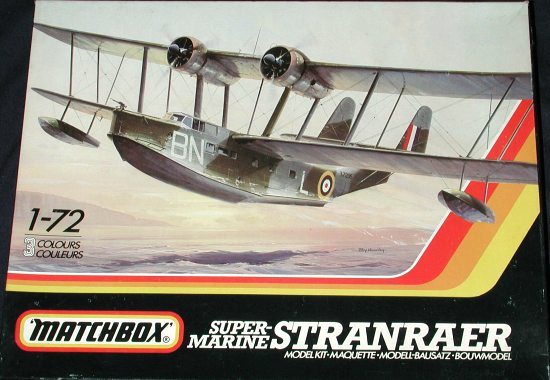
|
KIT: |
Matchbox 1/72 Stranraer |
|
KIT # |
PK 601 |
|
PRICE: |
$ |
|
DECALS: |
Three aircraft |
|
REVIEWER: |
|
|
NOTES: |
Hey, it's molded in three colors!!!! |

|
HISTORY |
The Stranraer was a large aircraft for its day with a wingspan of 85 feet 2 inches, a length of 54 feet 10 inches and a height of 21 feet 9 inches. Gross weight was 22,000 pounds. Maximum rated speed was165 miles per hour and its cruise speed was 105 miles per hour. Its operating range was 820 miles for an endurance of 8 hours. Armament was three Lewis machine guns – one each in the nose, amidships and the tail. It could also be armed with four 250-pound depth charges or two 500 pound bombs. The Stranraer was affectionately known as the "Whistling Bird Cage" (That's the PG version. It was more accurately known as the 'whistling shithouse') because of the many brace wires. It was considered by some airmen that flew it to be the best biplane flying boat ever built.
With the threat of the Second World War approaching, in 1936 the
RCAF began searching for a coastal patrol aircraft. It looked to the RAF for
suggestions and selected the Supermarine Stranraer, which had entered service in
that year. It then placed an order for the type for license manufacture by
Canadian Vickers. The Stranraer featured a hull manufactured from anodized
Alclad sheeting with wings and tail surfaces manufactured from duralumin and
covered with fabric. The Canadian prototype aircraft was delivered in 1938 and
with the outbreak of war additional aircraft were ordered into production. The
Stranraers served faithfully on both coasts during the early part of the war.
The Stranraers proved to be good seaworthy aircraft but their antiquate biplane
design eventually led to their being relegated to training duties. By 1944, some
had even been declared surplus and sold into civilian use. Stranraers' were
eventually replaced in both Canadian and British service by the PBY Catalina, a
plane that really wasn't much faster!
|
THE KIT |

Typical of Matchbox produced kits, this one is in a variety of colors. Detailing is minimal and surface detailing is raised panel lines. The fabric effect on the wing is a bit overdone, but some light sanding and paint should tone those down. Since this is a later kit (1983), the mad trencher didn't have any hand in doing this one. There is a semblance of a cockpit with pilot, seat and stick. no cabin detail is offered. The clear plastic for the windows is think and a bit distorted, so any real detailing won't be visible through it anyway. No options are provided other than beaching gear.
Instructions follow the usual Matchbox format with 13 major construction
steps, each clearly showing what goes where. The painting guide for smaller bits
is separate and offers only generic names for paints. A second large sheet is
dedicated almost  entirely to
exterior painting and decals. The markings are for three aircraft. One
camouflaged in Slate Grey and Sea Grey uppers with Aluminum undersides as shown
on the box art. This is the 240 Squadron plane. The other two, from 228 and 209
Squadron are in overall aluminum. The aluminum is a lacquer paint as bare metal
and salt water do not mix well. Matchbox decals are fairly good, even 20 year
old ones. The image still has the wax paper protective covering over it. They
are a bit thick, but should work well, even without setting solutions.
entirely to
exterior painting and decals. The markings are for three aircraft. One
camouflaged in Slate Grey and Sea Grey uppers with Aluminum undersides as shown
on the box art. This is the 240 Squadron plane. The other two, from 228 and 209
Squadron are in overall aluminum. The aluminum is a lacquer paint as bare metal
and salt water do not mix well. Matchbox decals are fairly good, even 20 year
old ones. The image still has the wax paper protective covering over it. They
are a bit thick, but should work well, even without setting solutions.
|
CONCLUSIONS |
It is pretty obvious from the fact that I've seen nearly none built up over the last 20 years that this is a kit that many buy, but few build. If like other Matchbox kits, fit should be fairly good and other than the work associated with rigging this beastie, shouldn't be too difficult a build.
If you would like your product reviewed fairly and quickly by a site that has well over 150,000 visitors a month, please contact me or see other details in the Note to Contributors.